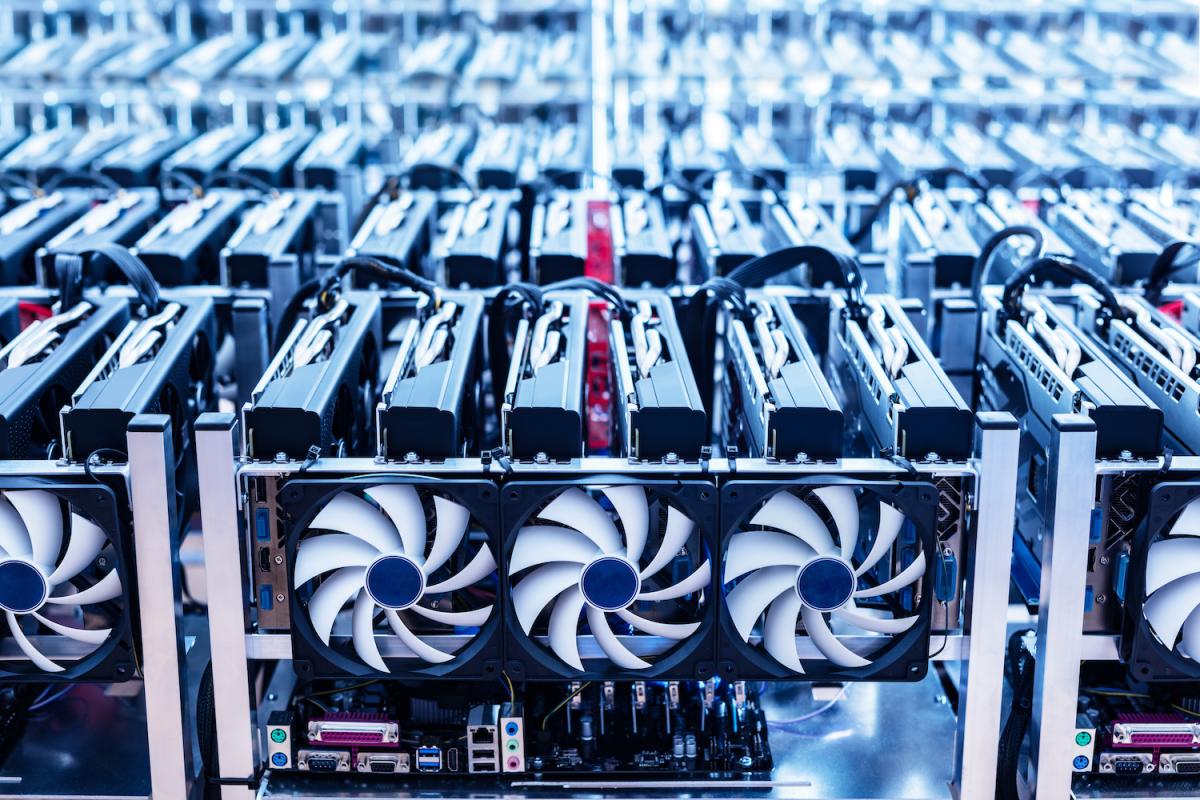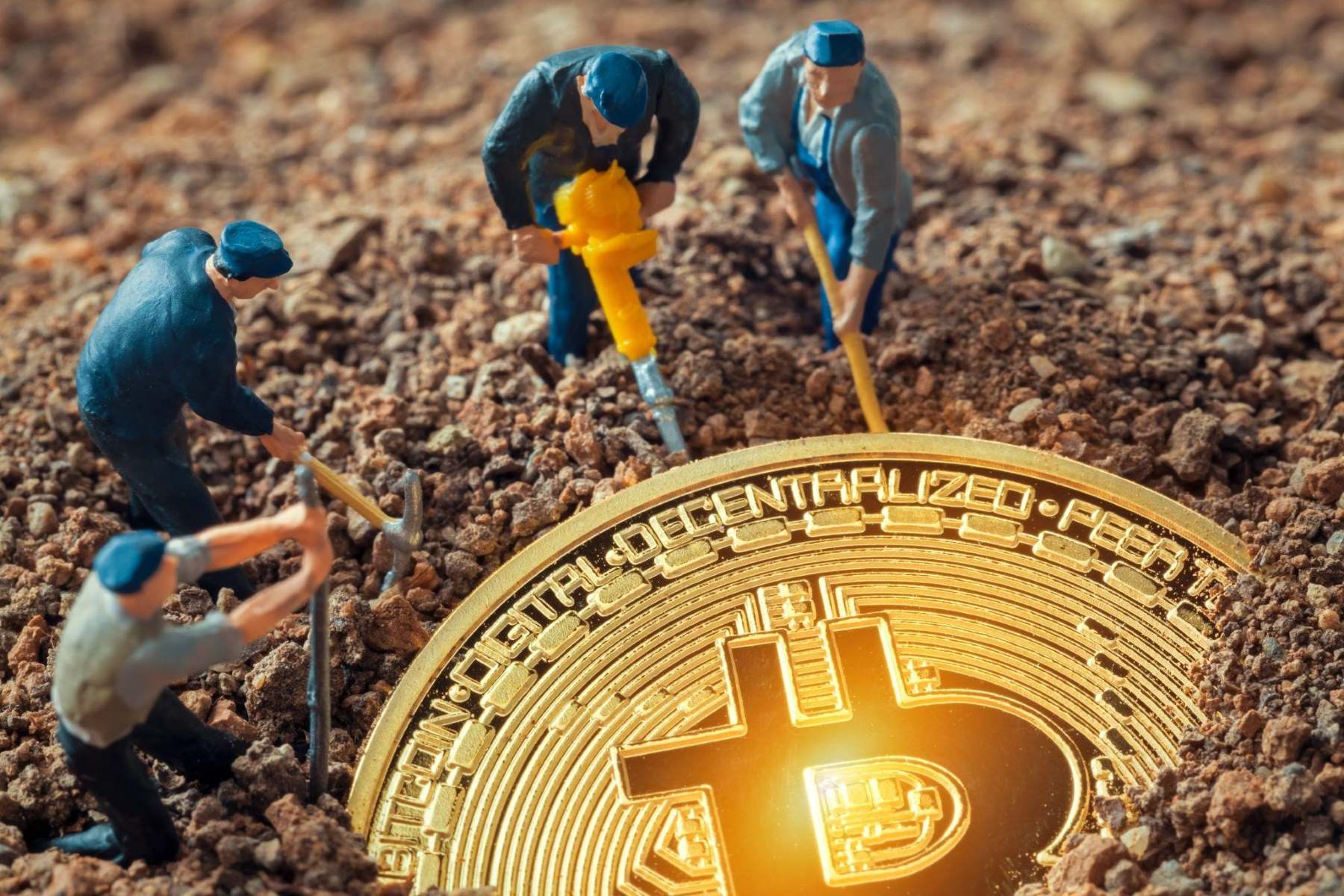Introduction
Welcome to the fascinating world of crypto mining! Cryptocurrencies like Bitcoin and Ethereum have gained tremendous popularity in recent years, leading to a surge in interest in mining these digital assets. Cryptocurrency mining involves solving complex mathematical problems to validate and secure transactions on the blockchain network.
By participating in the mining process, you have the opportunity to earn cryptocurrency rewards for your efforts. However, getting started with crypto mining can seem daunting, especially for newcomers. Rest assured, this guide will walk you through the essential steps to begin your mining journey.
Before we dive into the specifics, it’s crucial to understand that mining cryptocurrencies require substantial computational power and energy consumption. As a result, the hardware and software choices you make will significantly impact your mining success and profitability.
In this guide, we will cover everything you need to know to start your crypto mining adventure. We’ll discuss choosing the right hardware to maximize your mining efficiency, setting up a wallet to securely store your earnings, selecting the appropriate mining software, joining a mining pool for enhanced profitability, configuring your mining software for optimal performance, monitoring and managing your mining operation, understanding the costs and benefits, troubleshooting common issues, and staying updated with the latest developments in the mining industry.
Whether you’re an experienced miner looking to optimize your operation or a beginner taking your first steps, this guide will provide valuable insights and practical tips to help you navigate the world of crypto mining successfully. So let’s get started and unravel the mysteries of crypto mining together!
Choosing the Right Hardware
One of the most critical decisions you’ll make when starting your crypto mining journey is selecting the right hardware. The mining hardware you choose will determine your mining speed, power consumption, and overall profitability. Here are some key factors to consider when making your decision:
1. Hashrate: The hashrate of a mining rig refers to its computational power. It represents the number of mathematical calculations the hardware can perform per second. Generally, a higher hashrate leads to increased mining efficiency and better chances of earning rewards.
2. Energy Efficiency: Mining cryptocurrencies can be energy-intensive, so selecting energy-efficient hardware is crucial to minimize electricity costs. Look for mining rigs with high hashrates while consuming lower amounts of power.
3. Cost: Mining equipment can vary significantly in price. It’s essential to consider your budget and determine the best balance between performance and affordability. Remember to factor in additional expenses, such as cooling and maintenance.
4. Compatibility: Ensure that your hardware is compatible with the cryptocurrency you plan to mine. Different cryptocurrencies have varying mining algorithms, so research which hardware is suitable for your desired cryptocurrency.
5. Longevity: Consider the lifespan of the hardware you choose. Investing in durable and reliable equipment will ensure that your mining operation remains profitable for an extended period. Stay updated with the latest technology advancements to make informed decisions.
6. Scalability: Determine whether you plan to expand your mining operation in the future. If scalability is a consideration, choose hardware that allows for easy integration of additional rigs.
It’s essential to conduct thorough research and compare various hardware options before making a final decision. Websites and forums dedicated to crypto mining can provide valuable insights and user reviews. Additionally, keep an eye out for mining rig profitability calculators that can estimate potential earnings based on your hardware choices.
Remember, the crypto mining landscape is continually evolving, and new, more efficient hardware is regularly being released. Stay informed about the latest developments to ensure you’re making the most informed hardware decisions for your mining operation.
Setting Up a Wallet
Once you’ve chosen the right hardware for your crypto mining operation, the next step is to set up a wallet. A wallet is a secure digital storage space where you can store and manage your mined cryptocurrency. Here’s what you need to know about setting up a wallet:
1. Types of Wallets: There are several types of wallets available, each with its own advantages and security features. The main wallet options include:
- Software Wallets: These wallets are applications that you can install on your computer or mobile device. They provide convenient access to your cryptocurrency but may be vulnerable to malware or hacking attempts if not properly secured.
- Hardware Wallets: Hardware wallets are physical devices that store your private keys offline, providing enhanced security. They are less susceptible to online threats but may be less convenient to access.
- Web Wallets: These wallets are cloud-based and can be accessed from any device with an internet connection. While convenient, web wallets can be more susceptible to hacking attempts.
- Paper Wallets: A paper wallet involves printing out your private keys and storing them securely offline. While this method can provide high security, it can also be easily lost or damaged if not properly stored.
2. Security Measures: Regardless of the type of wallet you choose, it’s vital to prioritize security. Use strong, unique passwords, enable two-factor authentication (2FA), and regularly backup your wallet to safeguard your funds. Consider using offline, cold storage options for long-term storage of your cryptocurrency.
3. Wallet Compatibility: Ensure that the wallet you choose is compatible with the cryptocurrency you plan to mine. Different cryptocurrencies may have specific wallet requirements and address formats.
4. Research and Reviews: Before selecting a wallet, conduct thorough research and read user reviews. Look for wallets with a track record of security and reliability. The crypto community can provide valuable insights and recommendations.
5. Multiple Wallets: Depending on your mining activities and the number of cryptocurrencies you mine, you may need multiple wallets to manage your funds effectively. Consider using specific wallets for each cryptocurrency to maintain organization and security.
Setting up a wallet is a crucial step in your crypto mining journey. It allows you to securely store and manage your hard-earned cryptocurrency rewards. Take the time to research and select a wallet that aligns with your security requirements and preferences. Remember to keep your wallet and private keys safe and secure to protect your funds from unauthorized access.
Selecting the Right Mining Software
Once you have set up your hardware and wallet, the next crucial step in your crypto mining journey is selecting the right mining software. Mining software acts as an interface between your hardware and the cryptocurrency network, allowing you to control and manage your mining operation. Here’s what you need to consider when choosing mining software:
1. Compatibility: Ensure that the mining software you choose is compatible with your hardware and the cryptocurrency you plan to mine. Different cryptocurrencies use varying mining algorithms, so the software must support the specific algorithm of your chosen cryptocurrency.
2. Ease of Use: Look for mining software with a user-friendly interface and intuitive features. As a beginner, simplicity and ease of use will help you navigate the software settings and optimize your mining operation efficiently.
3. Performance and Efficiency: Mining software plays a crucial role in maximizing your mining efficiency and profitability. Look for software with advanced features such as optimized mining algorithms, automatic tuning, and overclocking capabilities to squeeze the most out of your hardware’s performance.
4. Stability and Reliability: It’s essential to choose mining software that is stable and reliable, minimizing the risk of crashes or malfunctions that can disrupt your mining operation. Research user reviews and feedback to gauge the software’s stability and reliability.
5. Customization and Monitoring: Advanced users may prefer software that offers extensive customization options and provides in-depth monitoring and reporting tools. These features allow you to fine-tune your mining settings and keep track of your mining performance in real-time.
6. Community and Support: Consider the software’s community and support network. Look for active development, regular updates, and a helpful community that can assist you with any questions or troubleshooting needs you may have.
7. Profitability Features: Some mining software offers additional features such as automatic switching between profitable cryptocurrencies or mining pools to optimize your earnings. Consider these features if you want to maximize your profitability.
It’s important to note that mining software is often specific to the operating system you are using, such as Windows, macOS, or Linux. Ensure that the software you choose is compatible with your operating system for a smooth mining experience.
Before making a final decision, it’s recommended to try out different mining software options and compare their performance and features. Take advantage of online resources and forums to gather information and user experiences. Remember that the best mining software for you will depend on your specific hardware, chosen cryptocurrency, and personal preferences.
Joining a Mining Pool
When it comes to crypto mining, joining a mining pool is a popular and practical choice for many miners. Mining pools allow multiple miners to combine their computational power, increasing the chances of solving mining puzzles and earning rewards. Here’s what you need to know about joining a mining pool:
1. Pool Types: There are different types of mining pools available, including pay-per-share (PPS), proportional, and solo mining pools. Each pool type distributes rewards differently, so it’s essential to understand the payout structure and choose a pool that aligns with your preferences.
2. Pool Size: Consider the size of the mining pool you want to join. Larger pools often offer more consistent payouts due to their higher computational power, while smaller pools may provide a more distributed reward system.
3. Pool Fees: Most mining pools charge a fee for their services, typically a percentage of the rewards earned. It’s important to research and compare the fees of different pools to ensure they are reasonable and aligned with the services provided.
4. Pool Reputation: Joining a reputable and well-established mining pool is crucial to ensure the security and reliability of your mining operation. Look for pools with a good track record, positive user reviews, and a transparent operational history.
5. Mining Pool Dashboard: Consider the user interface and features provided by the mining pool’s dashboard. A user-friendly and informative dashboard can make it easier to monitor your mining progress, track earnings, and configure payout settings.
6. Geographic Location: Some miners prefer to join pools located geographically close to them to reduce latency and improve mining efficiency. If this is a concern for you, consider searching for pools with servers in your region.
7. Diversification: If you mine multiple cryptocurrencies, consider joining different pools for each cryptocurrency to optimize your earnings and diversify your mining portfolio.
Joining a mining pool can enhance your mining experience by providing more regular and predictable rewards. Additionally, it allows you to connect and collaborate with other miners, fostering a sense of community within the crypto mining ecosystem.
Before joining a pool, take the time to research and compare different options. Explore pool statistics, payout histories, and user experiences to make an informed decision. It’s also beneficial to monitor the pool’s performance and your earnings to ensure a fair and profitable mining experience.
Remember, joining a mining pool is not mandatory, and some miners prefer solo mining. However, solo mining can be more challenging and unpredictable, especially for smaller mining operations. Ultimately, the choice between joining a pool or solo mining depends on your mining goals, resources, and preferences.
Configuring Your Mining Software
After selecting the right mining software for your setup, the next step is to configure it correctly. Proper configuration ensures that your mining software is optimized for performance, efficiency, and stability. Here are essential factors to consider when configuring your mining software:
1. Mining Pool Settings: If you’ve joined a mining pool, you’ll need to configure your software to connect to the pool’s server. This typically involves entering the pool’s URL, port number, and your mining pool username and password. Refer to the pool’s instructions or support documentation for the specific configuration details.
2. Algorithm and Intensity: Depending on the mining software and cryptocurrency you’re mining, you may have options to select the algorithm and intensity level. The algorithm determines the specific mathematical calculations performed, while the intensity affects the workload on your hardware. Experiment with different settings to find the optimal balance for your hardware and desired mining performance.
3. Mining Software Optimization: Mining software often comes with optimization features such as automatic tuning, overclocking, or power-saving modes. Utilize these features to maximize your mining efficiency and performance. However, be cautious with overclocking, as it can increase power consumption and potentially reduce hardware lifespan if not done properly.
4. GPU/CPU Settings: If you are mining with GPUs or CPUs, configure the specific settings for your hardware. This may involve adjusting core clock speed, memory clock speed, voltage, or fan speeds. Again, be careful with overclocking and ensure you understand the hardware’s capabilities and limitations.
5. Temperature and Cooling: Pay close attention to the temperature of your hardware while mining. Excessive heat can negatively impact performance and reduce the lifespan of your hardware. Ensure proper cooling by maintaining good ventilation, using fans or dedicated cooling solutions, and monitoring temperature levels using software or hardware monitoring tools.
6. Monitoring and Logging: Configure your mining software to provide detailed monitoring and logging information. Monitoring allows you to keep track of your mining performance, temperatures, fan speeds, and other crucial metrics. Logging can help you troubleshoot issues, identify potential hardware or software problems, and optimize your mining operation over time.
7. Automatic Restart: Consider enabling the automatic restart feature in your mining software to ensure continuous mining operation. This feature can automatically restart the mining process in the event of a crash or system failure, minimizing downtime and maximizing mining uptime.
Remember to save your configuration settings and monitor your mining operation closely after making any changes. Observe the performance, stability, and temperature of your hardware to ensure that the new settings are working optimally.
Additionally, stay updated with the latest versions of your mining software. Software updates often include bug fixes, performance improvements, and security enhancements. Regularly check the official website or community forums for updates and follow the recommended update procedures for your specific mining software.
By configuring your mining software properly, you can enhance your mining efficiency, improve stability, and maximize your potential earnings.
Monitoring and Managing Your Mining Operation
Once your mining operation is up and running, it’s crucial to monitor and manage it effectively to ensure optimal performance and profitability. Here are key aspects to consider when monitoring and managing your mining operation:
1. Mining Software Dashboard: Utilize the monitoring features provided by your mining software’s dashboard. Keep an eye on vital information such as hashrate, temperature, fan speed, and power consumption. Monitoring these metrics helps you identify any issues or abnormalities and take appropriate actions.
2. Mining Pool Statistics: Regularly check the statistics and updates provided by your mining pool. Monitor your mining rewards, shares submitted, and any notifications or messages from the pool. Staying informed keeps you up to date with your pool’s performance and ensures the accuracy of your earnings.
3. Network Hashrate and Difficulty: Keep an eye on the overall network hashrate and difficulty for the cryptocurrency you’re mining. These metrics impact the mining ecosystem and can affect your earnings. Adjust your mining strategy accordingly, especially during periods of significant changes in the network hashrate or difficulty.
4. Hardware Maintenance: Regularly maintain and clean your mining hardware to ensure longevity and optimal performance. Dust can accumulate and hinder airflow, leading to increased temperature and potential hardware failures. Follow the manufacturer’s guidelines for cleaning and maintenance, and consider periodic hardware inspections to identify any potential issues.
5. Electricity Costs: Be mindful of your electricity costs and monitor your energy consumption. Mining can be power-intensive, so look for ways to optimize energy usage without sacrificing performance. Consider mining during times of lower electricity rates, using energy-efficient hardware, or implementing power-saving settings when feasible.
6. Secure Your Wallet: Regularly update and back up your wallet to protect your earnings. Implement additional security measures such as two-factor authentication (2FA) or hardware wallets for enhanced protection against potential hacking or theft attempts.
7. Stay Informed: Keep up with relevant news, developments, and changes in the world of crypto mining. Stay informed about updates to mining software, changes in mining algorithms, potential forks or network upgrades, and any regulatory developments that may impact your mining operation.
8. Adapt and Optimize: Continuously analyze and optimize your mining strategy based on your hardware performance, cryptocurrency market conditions, and other factors that affect mining profitability. Experiment with different settings, algorithms, or even mining diversification to maximize your earnings.
Remember that mining is not a set-it-and-forget-it operation. Regularly monitor and manage your mining operation to ensure its efficiency and profitability. Keep track of hardware performance, network changes, and cost considerations to make informed decisions that align with your mining goals.
By actively monitoring and managing your mining operation, you can maintain a successful and profitable mining journey in the ever-evolving world of cryptocurrencies.
Understanding the Costs and Benefits
Before embarking on your crypto mining journey, it’s important to have a clear understanding of the costs and benefits involved. Mining cryptocurrencies can be both financially rewarding and resource-intensive. Here’s what you need to consider when assessing the costs and benefits of your mining operation:
1. Initial Investment: Mining requires an initial investment in hardware, software, and other mining accessories. Consider the cost of purchasing or building your mining rigs, as well as any additional equipment like cooling systems or power supplies.
2. Operational Costs: Mining incurs ongoing operational costs, primarily electricity. The energy consumption of mining rigs can vary significantly, so calculate your energy expenses based on the power consumption of your hardware and your electricity rate. Additionally, consider other potential costs such as internet connectivity, mining pool fees, and regular hardware maintenance.
3. Mining Rewards: The primary benefit of mining is the potential to earn rewards in the form of the mined cryptocurrency. Understand the reward system of your chosen cryptocurrency and mining pool, including factors such as block rewards, transaction fees, and payout frequency. Consider the current market value of the cryptocurrency and estimate potential earnings based on your mining performance and the network’s difficulty level.
4. Market Volatility: Cryptocurrency markets are notoriously volatile, and the value of mined coins can fluctuate significantly. Take into account the potential risks associated with market volatility and consider how it may impact your profitability over time. It is essential to evaluate the long-term potential of the cryptocurrency you are mining and have a strategy in place to manage price fluctuations.
5. Mining Difficulty: Mining difficulty levels determine how challenging it is to mine new blocks in a cryptocurrency’s blockchain. As more miners join the network, the difficulty increases, potentially reducing your mining profitability. Stay informed about changes in mining difficulty and factor it into your cost-benefit analysis.
6. Return on Investment (ROI): Calculate your potential return on investment to assess the profitability of your mining operation. Consider the initial investment, operational costs, and expected mining rewards over a projected period. It’s essential to evaluate the payback period for your investment and the potential long-term profitability given the current market conditions and mining landscape.
7. Environmental Impact: Mining consumes a significant amount of electricity, which can have an environmental impact. Consider the sustainability and ethical implications of your mining operation, and explore ways to minimize the carbon footprint, such as using renewable energy sources or joining eco-friendly mining initiatives.
Evaluating the costs and benefits of your mining operation allows you to make informed decisions and manage your expectations. Keep in mind that mining profitability can be influenced by various factors, and it’s important to regularly re-evaluate your strategy as market conditions and mining dynamics evolve.
Ultimately, the success of your mining operation depends on several variables, including hardware efficiency, energy costs, cryptocurrency market conditions, and your ability to adapt to changes in the industry. Conduct thorough research, analyze the potential costs and benefits, and determine if crypto mining aligns with your goals and resources.
Troubleshooting Common Issues
While crypto mining can be a rewarding endeavor, it is not without its challenges. Like any technological process, mining can encounter various issues that may affect performance or disrupt your operation. Understanding common problems and knowing how to troubleshoot them is crucial for a successful mining journey. Here are some common issues to be aware of and tips for troubleshooting:
1. Hardware Malfunctions: Hardware components can fail or malfunction, leading to mining disruptions. If you encounter hardware-related issues, check connections, power supply, and cooling systems. Monitor temperature levels and ensure that fans are functioning properly. Consider running hardware diagnostics to identify and resolve any potential hardware problems.
2. Software Glitches: Mining software may encounter glitches or crashes, disrupting mining operations. Restarting your mining software or the entire system can often resolve software-related issues. Ensure that you’re using the latest version of the mining software and that it is compatible with your hardware and operating system. Checking logs or error messages can provide valuable insights for troubleshooting software-related issues.
3. Internet Connectivity: Stable internet connectivity is crucial for successful mining. If you experience intermittent or slow internet connections, it can impact your mining efficiency and communication with mining pools. Troubleshoot your internet connection, reset routers or modems, and consider using a wired connection if possible. Ensure there are no firewall or antivirus settings blocking your mining software’s communication with the internet.
4. Network Congestion: During periods of high network congestion, mining can become slower or less profitable. Network congestion is often influenced by increased usage or transaction volumes. In such cases, consider adjusting your mining strategy, such as switching to a different mining pool or exploring mining opportunities during periods of lower congestion.
5. Hashrate Fluctuations: Fluctuating hashrates can be caused by various factors, including hardware performance issues or changes in mining difficulty. Monitor your hardware’s performance and ensure that it’s operating optimally. Additionally, stay informed about any changes in the cryptocurrency’s network difficulty and adjust your mining settings accordingly.
6. Cooling and Overheating: Overheating can degrade hardware performance and even lead to hardware failures. Ensure that cooling systems are functioning correctly and that proper ventilation is in place. Clean dust or debris that may obstruct airflow. Consider adjusting fan speeds or employing additional cooling methods if necessary.
7. Power Outages: Power outages can interrupt your mining operation and potentially cause data loss or hardware damage. Protect your mining equipment and data by using surge protectors, uninterruptible power supplies (UPS), or backup generators. Configure your mining software to automatically restart after power outages.
8. Pool Connection Issues: In case of frequent connection issues with your mining pool, verify that your mining software is correctly configured to connect to the pool. Check your internet connection stability, firewall settings, and verify that the mining pool’s server is not experiencing any downtime. Consider trying a different pool if connection issues persist.
Remember, troubleshooting mining issues requires patience and perseverance. Research online resources, consult relevant forums, or seek assistance from experienced miners. Stay updated with the latest developments and best practices in mining troubleshooting to effectively diagnose and resolve issues that may arise during your mining journey.
Staying Updated with the Latest Developments
In the rapidly evolving world of crypto mining, staying informed about the latest developments is crucial for a successful mining operation. Keeping up with industry trends, technological advancements, and market changes allows you to adapt your strategies and make informed decisions. Here’s how you can stay updated with the latest developments:
1. Follow Cryptocurrency News: Regularly follow reputable sources of cryptocurrency news. These sources provide updates on regulatory changes, market trends, technological breakthroughs, and industry developments. Subscribe to newsletters, follow industry experts on social media, and participate in relevant forums to stay engaged with the crypto community.
2. Join Mining Community Platforms: Engage with the wider mining community by joining online platforms and forums dedicated to mining. These platforms are excellent sources of information, where miners share knowledge, experiences, and insights. Participate in discussions, ask questions, and contribute to the community to enhance your understanding of the mining ecosystem.
3. Attend Mining Conferences and Events: Attend mining conferences, workshops, and webinars to network with industry professionals and learn about the latest mining trends. These events often feature presentations, panel discussions, and workshops where mining experts share valuable insights and knowledge. Stay updated with event calendars and make an effort to attend relevant conferences to expand your industry network and stay at the forefront of industry developments.
4. Join Mining Community Groups: Join mining-specific online communities or groups. These can be found on social media platforms or dedicated mining forums. Engage with other miners, ask questions, and obtain valuable guidance from experienced individuals. Share your experiences and contribute to the community, fostering a collaborative environment where miners support and learn from one another.
5. Stay informed about Mining Software Updates: Regularly check for updates from your mining software providers. Software updates often introduce new features, enhance performance, and address security vulnerabilities. By ensuring that your mining software is up to date, you can take advantage of the latest optimizations and improvements.
6. Follow Influencers and Experts: Identify key influencers and experts in the mining field and follow them on platforms like social media, YouTube, or blogs. These individuals often provide valuable insights, share mining strategies, and provide updates on industry developments. Learn from their experiences and integrate their advice into your mining approach.
7. Explore Research Papers and Whitepapers: Stay abreast of academic research and published whitepapers related to mining. These resources delve into advanced mining techniques, algorithm updates, and breakthroughs in mining technology. Accessing and understanding research papers can deepen your understanding of mining principles and support your overall mining knowledge.
8. Stay Open to Innovations: Embrace new ideas and technological innovations in the mining industry. New mining algorithms, hardware advancements, or alternative mining methods may emerge that offer more efficient or profitable mining opportunities. Stay open-minded and continuously evaluate new possibilities to adapt and optimize your mining operation.
By actively seeking out and staying updated with the latest developments in crypto mining, you can position yourself for success in an ever-changing landscape. Continuously learning, engaging with the mining community, and staying informed about industry trends ensures that you’re well-equipped to make informed decisions and navigate the evolving mining ecosystem.
Conclusion
Crypto mining offers a unique opportunity to participate in the vibrant world of cryptocurrencies and potentially earn rewards for your efforts. With the right hardware, software, and knowledge, you can embark on a rewarding mining journey. Throughout this guide, we have covered the essential steps to help you get started, from choosing the right hardware to staying updated with the latest developments in the mining industry.
Remember to carefully consider the costs and benefits of mining, including financial investments, operational expenses, and potential market volatility. By understanding the factors that impact mining profitability, you can make informed decisions and refine your mining strategy to maximize earnings.
Monitoring and managing your mining operation is crucial for long-term success. Regularly check hardware performance, monitor network and market conditions, and stay vigilant for common issues that may arise. Troubleshoot problems promptly to minimize downtime and ensure maximum mining efficiency.
Additionally, staying informed about the latest developments in the crypto mining industry is essential. Engage with the mining community, attend conferences and events, and follow industry experts and influencers. By staying up to date, you can adapt to changing circumstances, leverage new technologies, and enhance your mining operation.
As you venture into the world of crypto mining, always prioritize security and adhere to best practices. Protect your earnings through secure wallets, strong passwords, and diligent backup practices. Stay vigilant against potential threats and ensure that your mining operation aligns with ethical and environmental considerations.
Remember, mining is not a guaranteed path to wealth, and success requires ongoing education, adaptability, and persistence. Harness your passion for the industry, gather knowledge, and actively engage with the mining community.
With the information and insights provided in this guide, you are equipped to begin your mining journey. Embrace the challenges, continue to learn, and may your mining endeavors be fruitful and rewarding.

























